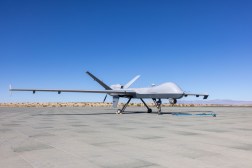House panel wants faster adoption of AI-enabled electromagnetic spectrum classification tools

A key congressional subcommittee wants the Pentagon to accelerate the development and adoption of artificial intelligence tools to classify electronic signals on the battlefield for conventional forces.
Under an “item of special interest” in the House Armed Services Subcommittee on Cyber, Information Technologies and Innovation mark for the fiscal 2024 National Defense Authorization Act, the panel expresses concern regarding the need for conventional forces to have greater visibility into what’s going on in the electromagnetic spectrum, as evidenced during the conflict between Russia and Ukraine.
“Maintaining the highest levels of battlefield awareness will require warfighters to have the ability to rapidly detect, analyze, and identify new signals in the electromagnetic spectrum (EMS). The ongoing conflict in Ukraine has exposed the threat that adversarial electronic warfare systems pose,” the provision states. “Accordingly, the committee believes that the Department of Defense should pursue capabilities that give the warfighter the ability to maintain awareness of the EMS environment and rapidly develop insights at the tactical edge.”
Items of special interest are ways the committee can express concern regarding an issue that could result in future legislation, but typically still require action on the part of the DOD, usually in the way of submitting a report.
The electromagnetic spectrum has become a highly dynamic, albeit invisible, environment on the battlefield in recent years. Forces must be adept at managing their electronic signatures to avoid detection while deploying advanced tools to detect, jam and strike enemy forces.
Given the cat-and-mouse game within this domain, it is critically important for militaries to be able to act upon signals once detected. However, if forces have detected a signal that’s not in their library, classifying it so they can understand it, can be challenging. However, artificial intelligence can help identify and classify signals, making it easier for militaries to be more adept within the EMS than their enemies.
In the subcommittee’s provision, it notes that special operations forces have successfully used AI-enabled electromagnetic spectrum classification tech in recent deployments, adding that the DOD should increase the adoption of these technologies for conventional units for more reliable awareness in the spectrum throughout the joint force.
Some of the services, along with the Defense Advanced Research Projects Agency, have invested in such technologies in the past, but lawmakers want to accelerate those efforts.
The subcommittee’s mark would direct the secretary of defense to submit a report by December 2023 on the Pentagon’s initiatives to expand these technologies. Such a report should include an assessment on conventional electromagnetic spectrum sensing and classification capabilities, efforts to expand the use of proven AI-enabled electromagnetic spectrum classification systems to conventional units, moves to develop next-generation classification systems and research regarding scalable, commercially available solutions that can meet requirements.
The subcommittee is scheduled to mark up the bill on Tuesday.






